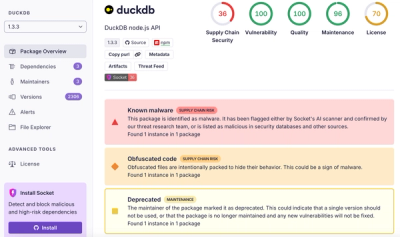
Security News
Feross on Risky Business Weekly Podcast: npm’s Ongoing Supply Chain Attacks
Socket CEO Feross Aboukhadijeh joins Risky Business Weekly to unpack recent npm phishing attacks, their limited impact, and the risks if attackers get smarter.
Python interface to the Google's Firebase REST APIs
$ pip install firebase
You can fetch any of your data in JSON format by appending '.json' to the end of the URL in which your data resides and, then send an HTTPS request through your browser. Like all other REST specific APIs, Firebase offers a client to update(PATCH, PUT), create(POST), or remove(DELETE) his stored data along with just to fetch it.
The library provides all the corresponding methods for those actions in both synchronous and asynchronous manner. You can just start an asynchronous GET request with your callback function, and the method
To fetch all the users in your storage simply do the following:
from firebase import firebase
firebase = firebase.FirebaseApplication('https://your_storage.firebaseio.com', None)
result = firebase.get('/users', None)
print(result)
>> {'1': 'Joe Tilsed', '2': 'Sydney Cox'}
The second argument of get method is the name of the snapshot. Thus, if you leave it NULL, you get the data in the URL /users.json. Besides, if you set it to 1, you get the data in the url /users/1.json. In other words, you get the user whose ID equals to 1.
from firebase import firebase
firebase = firebase.FirebaseApplication('https://your_storage.firebaseio.com', None)
result = firebase.get('/users', '1')
print(result)
>> {'1': 'Joe Tilsed'}
You can also provide extra query parameters that will be appended to the url or extra key-value pairs sent in the HTTP header.
from firebase import firebase
firebase = firebase.FirebaseApplication('https://your_storage.firebaseio.com', None)
result = firebase.get('/users/2', None, {'print': 'pretty'}, {'X_FANCY_HEADER': 'VERY FANCY'})
print(result)
>> {'2': 'Sydney Cox'}
Creating new data requires a POST or PUT request. Assuming you don't append print=silent to the url, if you use POST the returning value becomes the name of the snapshot, if PUT you get the data you just sent. If print=silent is provided, you get just NULL because the backend never sends an output.
from firebase import firebase
firebase = firebase.FirebaseApplication('https://your_storage.firebaseio.com', None)
new_user = 'Dave'
result = firebase.post('/users', new_user, {'print': 'pretty'}, {'X_FANCY_HEADER': 'VERY FANCY'})
print(result)
>> {u'name': u'<UID Hash>'}
result = firebase.post('/users', new_user, {'print': 'silent'}, {'X_FANCY_HEADER': 'VERY FANCY'})
print(result == None)
>> True
Deleting data is relatively easy compared to other actions. You just set the url and that's all. Backend sends no output as a result of a delete operation.
from firebase import firebase
firebase = firebase.FirebaseApplication('https://your_storage.firebaseio.com', None)
firebase.delete('/users', '3')
# Dave goes away.
Authentication in Firebase is nothing but to simply creating a token that conforms to the JWT standards and, putting it into the querystring with the name auth. The library creates that token for you so you never end up struggling with constructing a valid token on your own. If the data has been protected against write/read operations with some security rules, the backend sends an appropriate error message back to the client with the status code 403 Forbidden.
from firebase import firebase
firebase = firebase.FirebaseApplication('https://your_storage.firebaseio.com', authentication=None)
result = firebase.get('/users', None, {'print': 'pretty'})
print(result)
>> {'error': 'Permission denied.'}
authentication = firebase.FirebaseAuthentication('THIS_IS_MY_SECRET', 'Joe@Tilsed.com', extra={'id': 123})
firebase.authentication = authentication
print(authentication.extra)
>> {'admin': False, 'debug': False, 'email': 'Joe@Tilsed.com', 'id': 123, 'provider': 'password'}
user = authentication.get_user()
print(user.firebase_auth_token)
>> "eyJhbGciOiAiSFMyNTYiLCAidHlwIjogIkpXVCJ9.eyJhZG1pbiI6IGZhbHNlLCAiZGVidWciOiBmYWxzZSwgIml
hdCI6IDEzNjE5NTAxNzQsICJkIjogeyJkZWJ1ZyI6IGZhbHNlLCAiYWRtaW4iOiBmYWxzZSwgInByb3ZpZGVyIjog
InBhc3N3b3JkIiwgImlkIjogNSwgImVtYWlsIjogIm96Z3VydnRAZ21haWwuY29tIn0sICJ2IjogMH0.lq4IRVfvE
GQklslOlS4uIBLSSJj88YNrloWXvisRgfQ"
result = firebase.get('/users', None, {'print': 'pretty'})
print(result)
>> {'1': 'Joe Tilsed', '2': 'Sydney Cox'}
The interface heavily depends on the standart multiprocessing library when concurrency comes in. While creating an asynchronous call, an on-demand process pool is created and, the async method is executed by one of the idle process inside the pool. The pool remains alive until the main process dies. So every time you trigger an async call, you always use the same pool. When the method returns, the pool process ships the returning value back to the main process within the callback function provided.
import json
from firebase import firebase
from firebase import jsonutil
firebase = firebase.FirebaseApplication('https://your_storage.firebaseio.com', authentication=None)
def log_user(response):
with open('/tmp/users/%s.json' % response.keys()[0], 'w') as users_file:
users_file.write(json.dumps(response, cls=jsonutil.JSONEncoder))
firebase.get_async('/users', None, {'print': 'pretty'}, callback=log_user)
FAQs
Python interface to the Google's Firebase REST APIs
We found that firebase demonstrated a healthy version release cadence and project activity because the last version was released less than a year ago. It has 1 open source maintainer collaborating on the project.
Did you know?

Socket for GitHub automatically highlights issues in each pull request and monitors the health of all your open source dependencies. Discover the contents of your packages and block harmful activity before you install or update your dependencies.

Security News
Socket CEO Feross Aboukhadijeh joins Risky Business Weekly to unpack recent npm phishing attacks, their limited impact, and the risks if attackers get smarter.

Product
Socket’s new Tier 1 Reachability filters out up to 80% of irrelevant CVEs, so security teams can focus on the vulnerabilities that matter.

Research
/Security News
Ongoing npm supply chain attack spreads to DuckDB: multiple packages compromised with the same wallet-drainer malware.